MITSUBISHI iMiEV 2015 (in English) Manual Online
Manufacturer: MITSUBISHI, Model Year: 2015, Model line: iMiEV, Model: MITSUBISHI iMiEV 2015Pages: 262, PDF Size: 26.84 MB
Page 81 of 262
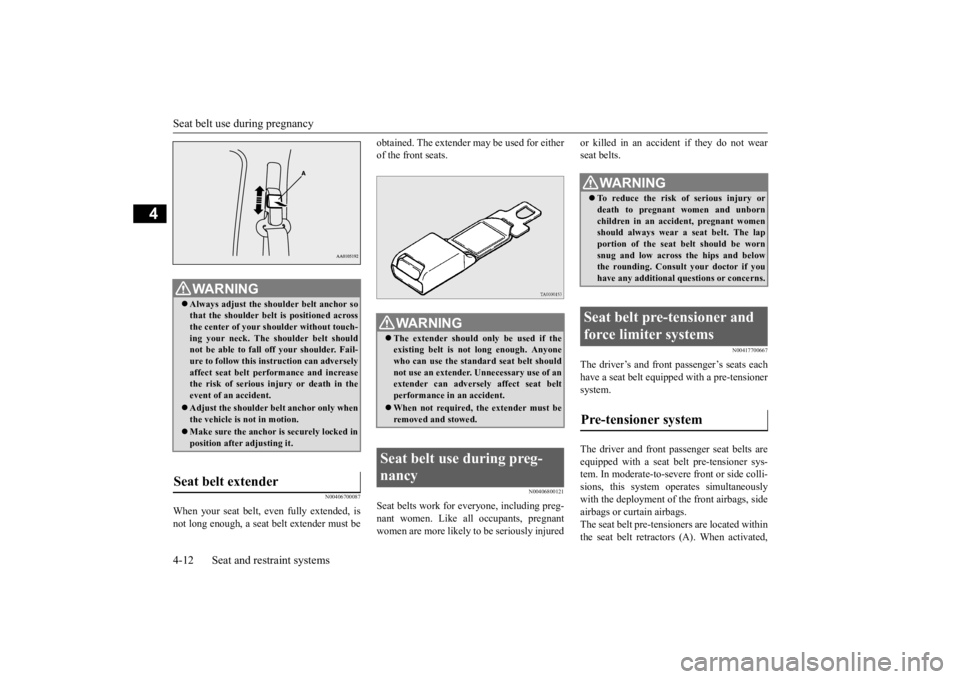
Seat belt use during pregnancy 4-12 Seat and restraint systems
4
N00406700087
When your seat belt, even fully extended, is not long enough, a seat belt extender must be
obtained. The extender may be used for either of the front seats.
N00406800121
Seat belts work for everyone, including preg-nant women. Like al
l occupants, pregnant
women are more likely to be seriously injured
or killed in an accide
nt if they do not wear
seat belts.
N00417700667
The driver’s and front passenger’s seats eachhave a seat belt equippe
d with a pre-tensioner
system. The driver and front pa
ssenger seat belts are
equipped with a seat belt pre-tensioner sys- tem. In moderate-to-seve
re front or side colli-
sions, this system ope
rates simultaneously
with the deployment of the front airbags, side airbags or curtain airbags. The seat belt pre-tensi
oners are located within
the seat belt retractors (A). When activated,
WA R N I N G Always adjust the shou
lder belt anchor so
that the shoulder belt
is positioned across
the center of your shoulder without touch- ing your neck. The sh
oulder belt should
not be able to fall off your shoulder. Fail-ure to follow this instruction can adversely affect seat belt performance and increase the risk of serious in
jury or death in the
event of an accident. Adjust the shoulder be
lt anchor only when
the vehicle is not in motion. Make sure the anchor is securely locked in position after adjusting it.
Seat belt extender
WA R N I N G The extender should only be used if the existing belt is not long enough. Anyonewho can use the standard seat belt should not use an extender.
Unnecessary use of an
extender can adversel
y affect seat belt
performance in an accident. When not required, the extender must be removed and stowed.
Seat belt use during preg- nancy
WA R N I N G To reduce the risk of serious injury or death to pregnant women and unborn children in an accident, pregnant women should always wear
a seat belt. The lap
portion of the seat belt should be worn snug and low across the hips and below the rounding. Consult your doctor if youhave any additional qu
estions or concerns.
Seat belt pre-tensioner and force limiter systems Pre-tensioner system
BK0209800US.book 12 ページ 2014年1月14日 火曜日 午前9時26分
Page 82 of 262
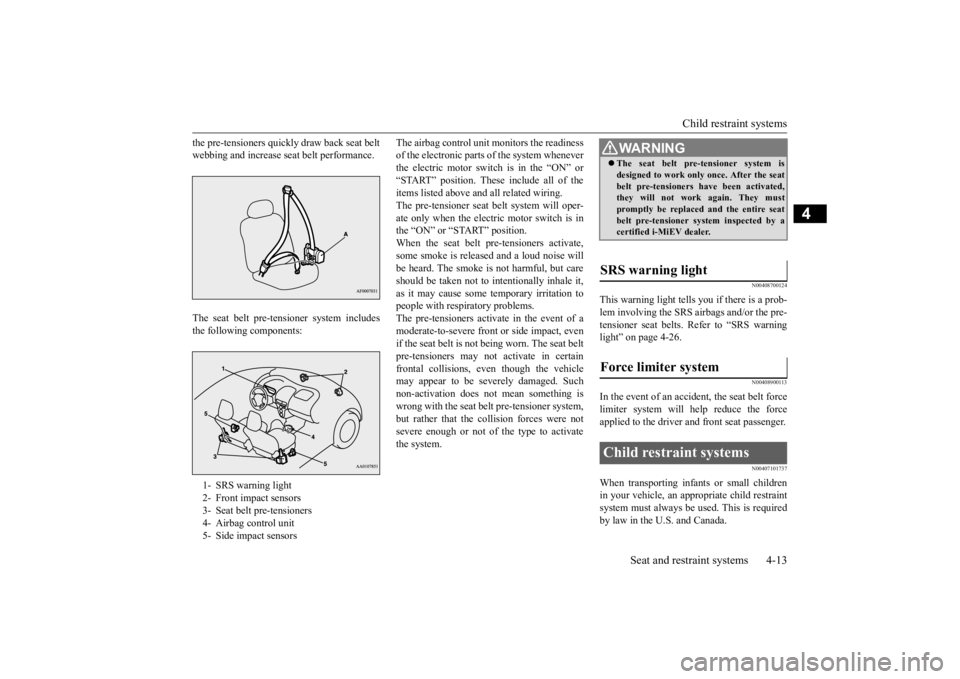
Child restraint systems
Seat and restraint systems 4-13
4
the pre-tensioners quickly
draw back seat belt
webbing and increase se
at belt performance.
The seat belt pre-tensioner system includes the following components:
The airbag control unit
monitors the readiness
of the electronic parts of the system wheneverthe electric motor switch is in the “ON” or “START” position. Thes
e include all of the
items listed above a
nd all related wiring.
The pre-tensioner seat
belt system will oper-
ate only when the electric motor switch is in the “ON” or “START” position.When the seat belt pre-tensioners activate, some smoke is released
and a loud noise will
be heard. The smoke is
not harmful, but care
should be taken not to in
tentionally inhale it,
as it may cause some
temporary irritation to
people with respiratory problems. The pre-tensioners activa
te in the event of a
moderate-to-severe front
or side impact, even
if the seat belt is not being worn. The seat belt pre-tensioners may not
activate in certain
frontal collisions, even though the vehiclemay appear to be se
verely damaged. Such
non-activation does not mean something is wrong with the seat belt pre-tensioner system,but rather that the collision forces were not severe enough or not of the type to activate the system.
N00408700124
This warning light tells you if there is a prob-lem involving the SRS airbags and/or the pre- tensioner seat belts. Refer to “SRS warning light” on page 4-26.
N00408900113
In the event of an accident, the seat belt forcelimiter system will help reduce the forceapplied to the driver a
nd front seat passenger.
N00407101737
When transporting infants or small children in your vehicle, an appr
opriate child restraint
system must always be
used. This is required
by law in the U.S. and Canada.
1- SRS warning light 2- Front impact sensors 3- Seat belt pr
e-tensioners
4- Airbag control unit 5- Side impact sensors
WA R N I N G The seat belt pre-tensioner system is designed to work only
once. After the seat
belt pre-tensioners have been activated,they will not work again. They must promptly be replaced and the entire seat belt pre-tensioner system inspected by acertified i-MiEV dealer.
SRS warning light Force limiter system Child restraint systems
BK0209800US.book 13 ページ 2014年1月14日 火曜日 午前9時26分
Page 83 of 262
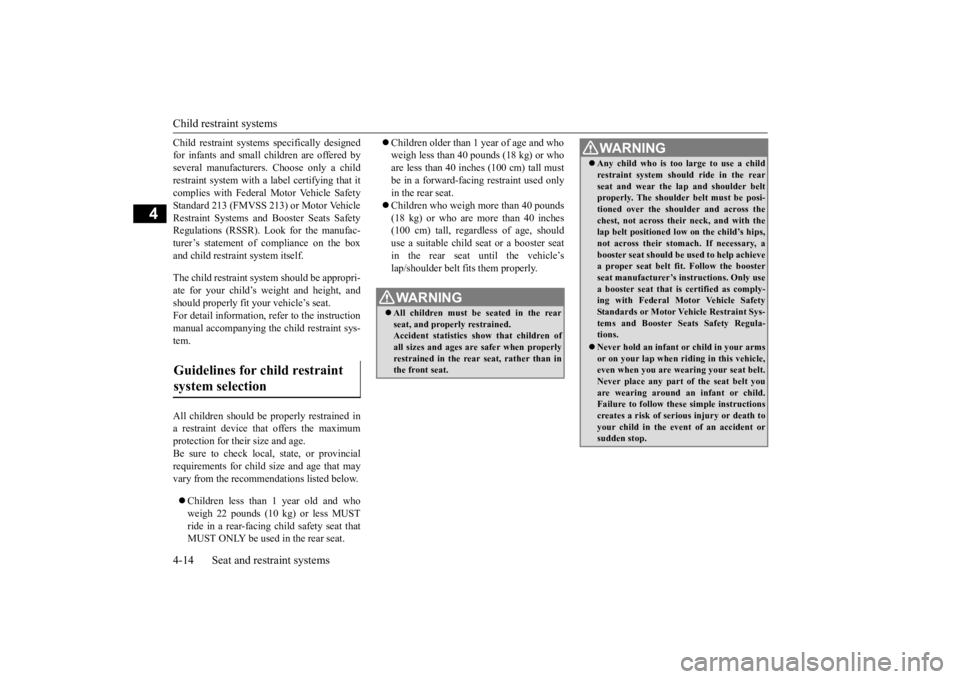
Child restraint systems 4-14 Seat and restraint systems
4
Child restraint systems specifically designed for infants and small children are offered byseveral manufacturers
. Choose only a child
restraint system with a label certifying that it complies with Federal Motor Vehicle SafetyStandard 213 (FMVSS 213) or Motor Vehicle Restraint Systems and Booster Seats Safety Regulations (RSSR). Look for the manufac-turer’s statement of compliance on the box and child restraint system itself. The child restraint system should be appropri- ate for your child’s we
ight and height, and
should properly fit you
r vehicle’s seat.
For detail information, refer to the instructionmanual accompanying the child restraint sys- tem. All children should be
properly restrained in
a restraint device that
offers the maximum
protection for their size and age. Be sure to check local, state, or provincial requirements for child size and age that mayvary from the recommendations listed below. Children less than 1 year old and who weigh 22 pounds (10 kg) or less MUST ride in a rear-facing child safety seat thatMUST ONLY be used in the rear seat.
Children older than 1 year of age and who weigh less than 40 pounds (18 kg) or whoare less than 40 inches (100 cm) tall must be in a forward-facing restraint used only in the rear seat. Children who weigh more than 40 pounds (18 kg) or who are more than 40 inches (100 cm) tall, regardless of age, shoulduse a suitable child seat or a booster seat in the rear seat until the vehicle’s lap/shoulder belt fits them properly.
Guidelines for child restraint system selection
WA R N I N G All children must be seated in the rear seat, and properly restrained. Accident statistics
show that children of
all sizes and ages are safer when properlyrestrained in the rear seat, rather than in the front seat.
Any child who is too large to use a child restraint system should ride in the rearseat and wear the la
p and shoulder belt
properly. The shoulder belt must be posi- tioned over the shou
lder and across the
chest, not across their neck, and with thelap belt positioned low on the child’s hips, not across their stomach. If necessary, a booster seat should be used to help achievea proper seat belt fi
t. Follow the booster
seat manufacturer’s instructions. Only use a booster seat that is certified as comply-ing with Federal Motor Vehicle Safety Standards or Motor Vehicle Restraint Sys- tems and Booster Seats Safety Regula-tions. Never hold an infant
or child in your arms
or on your lap when ri
ding in this vehicle,
even when you are we
aring your seat belt.
Never place any part of the seat belt youare wearing around an infant or child. Failure to follow these simple instructions creates a risk of serious injury or death toyour child in the event of an accident or sudden stop.WA R N I N G
BK0209800US.book 14 ページ 2014年1月14日 火曜日 午前9時26分
Page 84 of 262
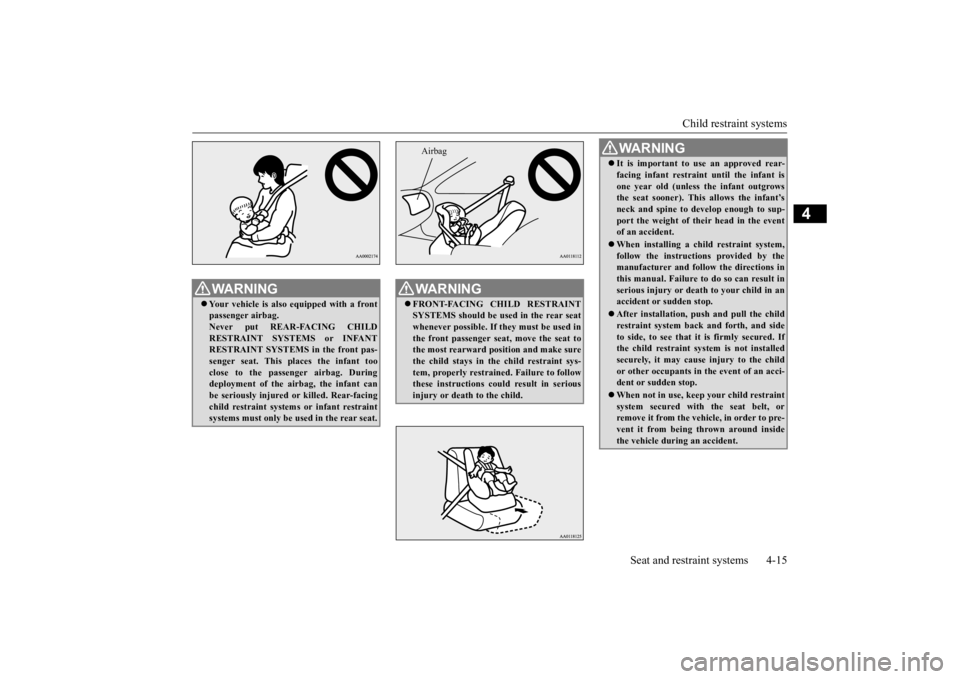
Child restraint systems
Seat and restraint systems 4-15
4
WA R N I N G Your vehicle is also
equipped with a front
passenger airbag.Never put REAR-FACING CHILD RESTRAINT SYSTEMS or INFANT RESTRAINT SYSTEMS in the front pas-senger seat. This pl
aces the infant too
close to the passenger airbag. During deployment of the airbag, the infant canbe seriously injured or
killed. Rear-facing
child restraint systems or infant restraint systems must only be used in the rear seat.
WA R N I N G FRONT-FACING CHILD RESTRAINT SYSTEMS should be used in the rear seatwhenever possible. If they must be used in the front passenger seat, move the seat to the most rearward po
sition and make sure
the child stays in the child restraint sys- tem, properly restrained. Failure to follow these instructions could result in seriousinjury or death to the child.Airbag
WA R N I N G It is important to use an approved rear- facing infant restraint until the infant isone year old (unless
the infant outgrows
the seat sooner). This
allows the infant’s
neck and spine to de
velop enough to sup-
port the weight of their head in the eventof an accident. When installing a child restraint system, follow the instructions provided by the manufacturer and follow the directions in this manual. Failure to do so can result inserious injury or deat
h to your child in an
accident or
sudden stop.
After installation, push
and pull the child
restraint system back and forth, and side to side, to see that it is firmly secured. Ifthe child restraint system is not installed securely, it may cause injury to the child or other occupants in
the event of an acci-
dent or sudden stop. When not in use, keep your child restraint system secured with the seat belt, or remove it from the vehicle, in order to pre- vent it from being
thrown around inside
the vehicle during an accident.
BK0209800US.book 15 ページ 2014年1月14日 火曜日 午前9時26分
Page 85 of 262
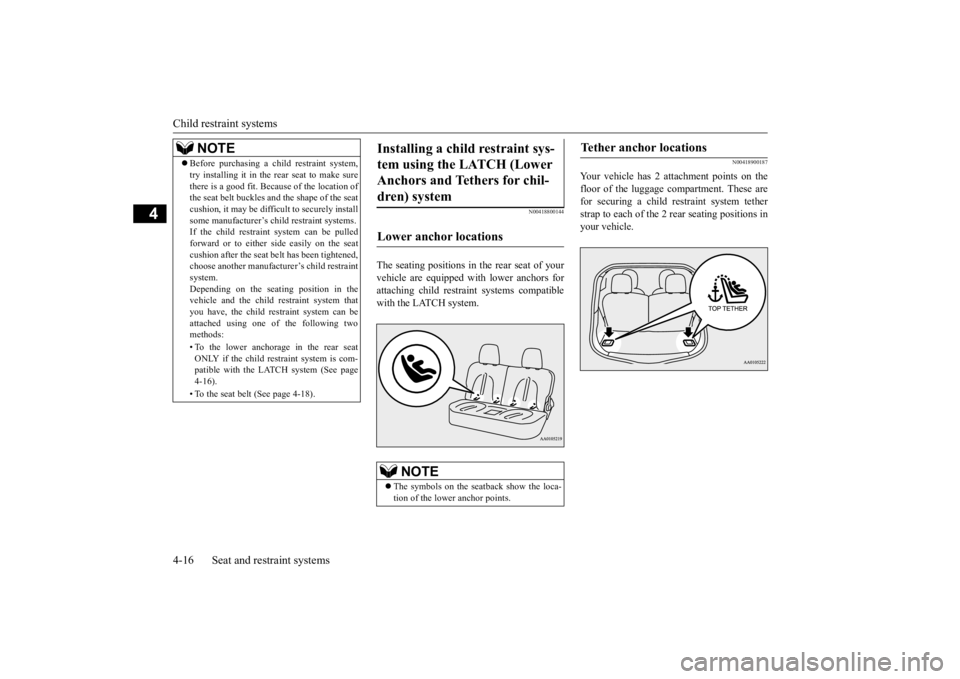
Child restraint systems 4-16 Seat and restraint systems
4
N00418800144
The seating positions in the rear seat of your vehicle are equipped with lower anchors for attaching child restraint systems compatible with the LATCH system.
N00418900187
Your vehicle has 2 attachment points on thefloor of the luggage compartment. These are for securing a child restraint system tetherstrap to each of the 2
rear seating positions in
your vehicle.
NOTE
Before purchasing a child restraint system, try installing it in the rear seat to make surethere is a good fit. Because of the location ofthe seat belt buckles and the shape of the seat cushion, it may be diffic
ult to securely install
some manufacturer’s child restraint systems.If the child restraint system can be pulled forward or to either side easily on the seat cushion after the seat
belt has been tightened,
choose another manufactu
rer’s child restraint
system. Depending on the seating position in thevehicle and the child restraint system that you have, the child restraint system can be attached using one of the following twomethods: • To the lower anchorage in the rear seat ONLY if the child restraint system is com- patible with the LATCH system (See page 4-16). • To the seat belt (See page 4-18).
Installing a child restraint sys- tem using the LATCH (Lower Anchors and Tethers for chil- dren) system Lower anchor locations
NOTE
The symbols on the seatback show the loca- tion of the lower anchor points.
Tether anchor locations
BK0209800US.book 16 ページ 2014年1月14日 火曜日 午前9時26分
Page 86 of 262
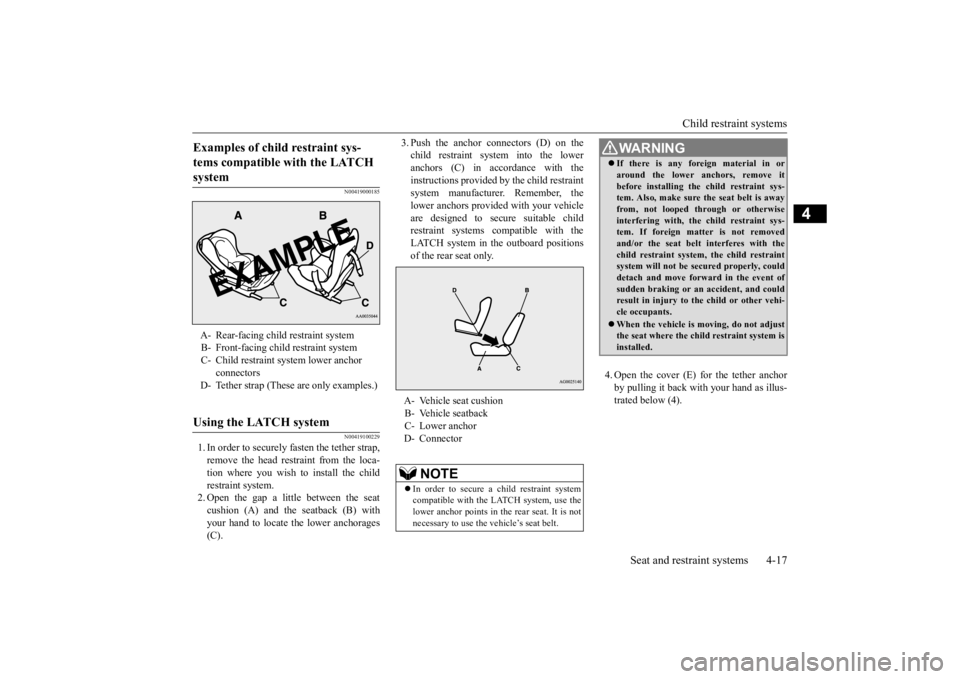
Child restraint systems
Seat and restraint systems 4-17
4
N00419000185 N00419100229
1. In order to securely fasten the tether strap, remove the head restraint from the loca-tion where you wish to install the child restraint system. 2. Open the gap a little between the seatcushion (A) and the seatback (B) with your hand to locate the lower anchorages (C).
3. Push the anchor connectors (D) on the child restraint system into the loweranchors (C) in accordance with the instructions provided by the child restraint system manufacturer. Remember, thelower anchors provided with your vehicle are designed to secure suitable child restraint systems compatible with theLATCH system in the outboard positions of the rear seat only.
4. Open the cover (E) for the tether anchor by pulling it back with your hand as illus- trated below (4).
Examples of child restraint sys- tems compatible with the LATCH system A- Rear-facing child
restraint system
B- Front-facing child restraint system C- Child restraint system lower anchor
connectors
D- Tether strap (These are only examples.)Using the LATCH system
A- Vehicle seat cushion B- Vehicle seatback C- Lower anchorD- Connector
NOTE
In order to secure a child restraint system compatible with the LATCH system, use thelower anchor points in th
e rear seat. It is not
necessary to use the
vehicle’s seat belt.
WA R N I N GIf there is any foreign material in or around the lower anchors, remove itbefore installing the child restraint sys-tem. Also, make sure the seat belt is away from, not looped through or otherwise interfering with, the child restraint sys-tem. If foreign matter is not removed and/or the seat belt interferes with the child restraint system, the child restraintsystem will not be secured properly, could detach and move forward in the event of sudden braking or an
accident, and could
result in injury to the child or other vehi- cle occupants. When the vehicle is moving, do not adjust the seat where the child restraint system is installed.
BK0209800US.book 17 ページ 2014年1月14日 火曜日 午前9時26分
Page 87 of 262
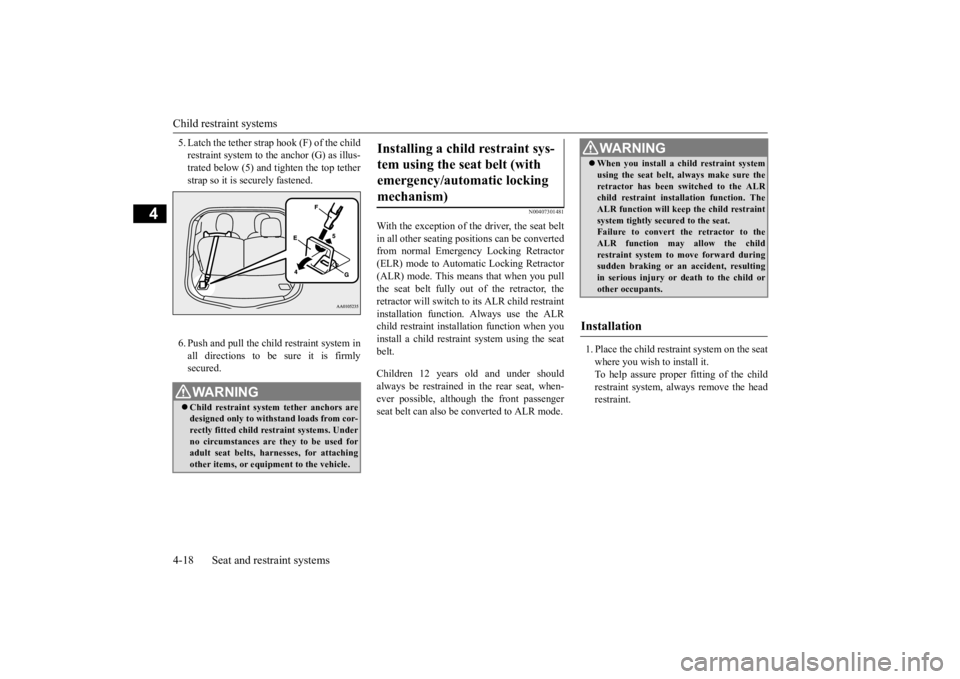
Child restraint systems 4-18 Seat and restraint systems
4
5. Latch the tether strap hook (F) of the child restraint system to th
e anchor (G) as illus-
trated below (5) and tighten the top tether strap so it is securely fastened. 6. Push and pull the child restraint system in all directions to be sure it is firmlysecured.
N00407301481
With the exception of the driver, the seat belt in all other seating pos
itions can be converted
from normal Emergency Locking Retractor(ELR) mode to Automatic Locking Retractor (ALR) mode. This means that when you pull the seat belt fully out of the retractor, the retractor will switch to its ALR child restraint installation function.
Always use the ALR
child restraint installation function when you install a child restraint system using the seat belt. Children 12 years old and under should always be restrained in the rear seat, when- ever possible, although the front passenger seat belt can also be converted to ALR mode.
1. Place the child restraint system on the seat where you wish to install it. To help assure proper fitting of the child restraint system, alwa
ys remove the head
restraint.
WA R N I N G Child restraint system tether anchors are designed only to with
stand loads from cor-
rectly fitted child restraint systems. Underno circumstances are they to be used for adult seat belts, harnesses, for attaching other items, or equipment to the vehicle.
Installing a child restraint sys- tem using the seat belt (with emergency/automatic locking mechanism)
WA R N I N G When you install a child restraint system using the seat belt, always make sure theretractor has been switched to the ALRchild restraint instal
lation function. The
ALR function will keep the child restraint system tightly secured to the seat.Failure to convert the retractor to the ALR function may allow the child restraint system to move forward duringsudden braking
or an accide
nt, resulting
in serious injury or
death to the child or
other occupants.
Installation
BK0209800US.book 18 ページ 2014年1月14日 火曜日 午前9時26分
Page 88 of 262

Child restraint systems
Seat and restraint systems 4-19
4
2. Route the seat belt through the child restraint system acco
rding to the instruc-
tions provided by the child restraint sys- tem manufacturer. Then insert the seat belt latch plate into
the buckle. Make sure
you hear a “click” when you insert the latch plate into the buckle.
3. To activate the ALR child restraint instal- lation function, slowly pull the shoulderpart of the belt all the way out of the retractor until it stops. Then let the belt feed back into the retractor. 4. After the belt has retracted, tug on it. If the belt is in the ALR function, you will not be able to pull it out. If the webbingcan be pulled out from retractor, the ALR function has not been activated and you will need to repeat steps 3 and 4.
5. After confirming that the belt is locked, grab the shoulder part of the belt near thebuckle and pull up to remove any slack from the lap part of the belt allowing the slack to feed into the retractor. Remember,if the lap belt portion is not tight, the child restraint system
will not be secure. It may
help to put your weight on the childrestraint system and/or push on its seat- back while pulling up on the belt (see illustration). 6. Open the cover from the tether anchor installation point by
pulling it back with
your hand as illustrated below (6).
If your child restraint system requires the use of a tether strap, fasten the tether strap in accordance with the following procedures.
BK0209800US.book 19 ページ 2014年1月14日 火曜日 午前9時26分
Page 89 of 262
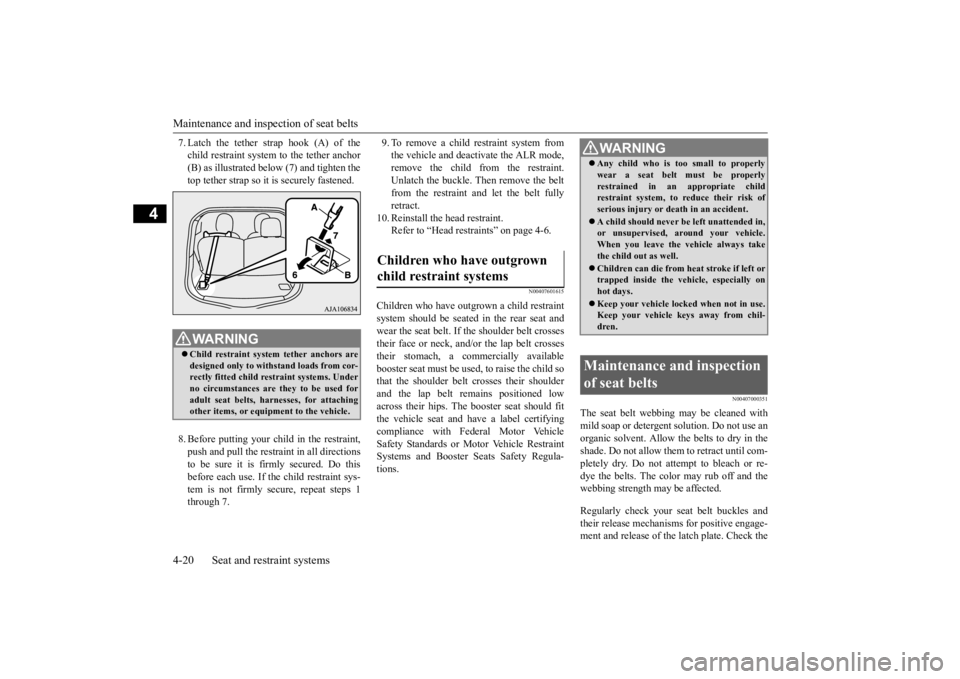
Maintenance and inspection of seat belts 4-20 Seat and restraint systems
4
7. Latch the tether strap hook (A) of the child restraint system to the tether anchor(B) as illustrated below (7) and tighten the top tether strap so it is securely fastened. 8. Before putting your child in the restraint, push and pull the restraint in all directions to be sure it is firmly secured. Do thisbefore each use. If
the child restraint sys-
tem is not firmly se
cure, repeat steps 1
through 7.
9. To remove a child restraint system from the vehicle and deac
tivate the ALR mode,
remove the child from the restraint. Unlatch the buckle. Th
en remove the belt
from the restraint and let the belt fullyretract.
10. Reinstall the head restraint.
Refer to “Head restraints” on page 4-6.
N00407601615
Children who have outgrown a child restraint system should be seated in the rear seat and wear the seat belt. If the shoulder belt crossestheir face or neck, and/
or the lap belt crosses
their stomach, a commercially available booster seat must be used, to raise the child sothat the shoulder belt
crosses their shoulder
and the lap belt remains positioned low across their hips. The booster seat should fitthe vehicle seat and ha
ve a label certifying
compliance with Federal Motor Vehicle Safety Standards or Mo
tor Vehicle Restraint
Systems and Booster Seats Safety Regula- tions.
N00407000351
The seat belt webbing may be cleaned withmild soap or detergent solution. Do not use an organic solvent. Allow the belts to dry in theshade. Do not allow them to retract until com- pletely dry. Do not attempt to bleach or re- dye the belts. The color may rub off and thewebbing strength may be affected. Regularly check your seat belt buckles and their release mechanisms for positive engage- ment and release of the latch plate. Check the
WA R N I N G Child restraint system tether anchors are designed only to with
stand loads from cor-
rectly fitted child restraint systems. Underno circumstances are they to be used for adult seat belts, harnesses, for attaching other items, or equipment to the vehicle.
Children who have outgrown child restraint systems
WA R N I N G Any child who is too small to properly wear a seat belt
must be properly
restrained in an appropriate childrestraint system, to reduce their risk of serious injury or de
ath in an
accident.
A child should never be
left unattended in,
or unsupervised, around your vehicle. When you leave the
vehicle always take
the child out as well. Children can die from heat stroke if left or trapped inside the vehicle, especially on hot days. Keep your vehicle locked when not in use. Keep your vehicle keys away from chil- dren.
Maintenance and inspection of seat belts
BK0209800US.book 20 ページ 2014年1月14日 火曜日 午前9時26分
Page 90 of 262
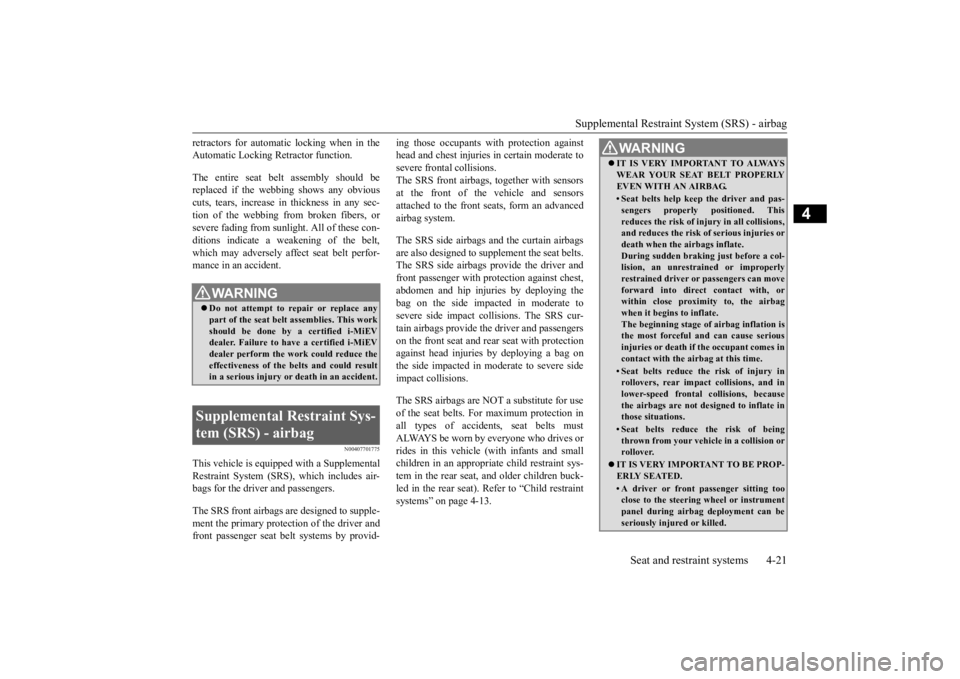
Supplemental Restraint System (SRS) - airbag
Seat and restraint systems 4-21
4
retractors for automatic locking when in the Automatic Locking Retractor function. The entire seat belt assembly should be replaced if the webbing shows any obvious cuts, tears, increase in thickness in any sec- tion of the webbing from broken fibers, orsevere fading from sunlig
ht. All of these con-
ditions indicate a weakening of the belt, which may adversely affe
ct seat belt perfor-
mance in an accident.
N00407701775
This vehicle is equippe
d with a Supplemental
Restraint System (SRS), which includes air-bags for the driver and passengers. The SRS front airbags are designed to supple- ment the primary protection of the driver and front passenger seat
belt systems by provid-
ing those occupants w
ith protection against
head and chest injuries
in certain moderate to
severe frontal
collisions.
The SRS front airbags, together with sensors at the front of the
vehicle and sensors
attached to the front seats, form an advanced airbag system. The SRS side airbags and the curtain airbags are also designed to supp
lement the seat belts.
The SRS side airbags provide the driver and front passenger with pr
otection against chest,
abdomen and hip injuries by deploying the bag on the side impacted in moderate to severe side impact collisions. The SRS cur-tain airbags provide the driver and passengers on the front seat and rear seat with protection against head injuries by deploying a bag onthe side impacted in m
oderate to severe side
impact collisions. The SRS airbags are NOT a substitute for use of the seat belts. For maximum protection inall types of accident
s, seat belts must
ALWAYS be worn by everyone who drives or rides in this vehicle
(with infants and small
children in an appropriate child restraint sys- tem in the rear seat, and older children buck- led in the rear seat). Re
fer to “Child restraint
systems” on page 4-13.
WA R N I N G Do not attempt to repair or replace any part of the seat belt assemblies. This workshould be done by a certified i-MiEV dealer. Failure to have a certified i-MiEV dealer perform the work could reduce theeffectiveness of the belts and could result in a serious injury or
death in an accident.
Supplemental Restraint Sys- tem (SRS) - airbag
WA R N I N G IT IS VERY IMPORTANT TO ALWAYS WEAR YOUR SEAT BELT PROPERLYEVEN WITH AN AIRBAG.• Seat belts help keep the driver and pas-sengers properly positioned. Thisreduces the risk of injury in all collisions, and reduces the risk of serious injuries or death when the
airbags inflate.
During sudden braking just before a col- lision, an unrestra
ined or
improperly
restrained driver or passengers can moveforward into direct contact with, or within close proximi
ty to, the airbag
when it begins to inflate.The beginning stage of
airbag inflation is
the most forceful and can cause serious injuries or death if the occupant comes incontact with the airbag at this time. • Seat belts reduce the risk of injury inrollovers, rear impact collisions, and in lower-speed frontal collisions, because the airbags are not de
signed to inflate in
those situations.• Seat belts reduce the risk of beingthrown from your vehi
cle in a collision or
rollover.
IT IS VERY IMPORTANT TO BE PROP- ERLY SEATED.• A driver or front passenger sitting tooclose to the steering wheel or instrument panel during airbag deployment can beseriously injured or killed.
BK0209800US.book 21 ページ 2014年1月14日 火曜日 午前9時26分